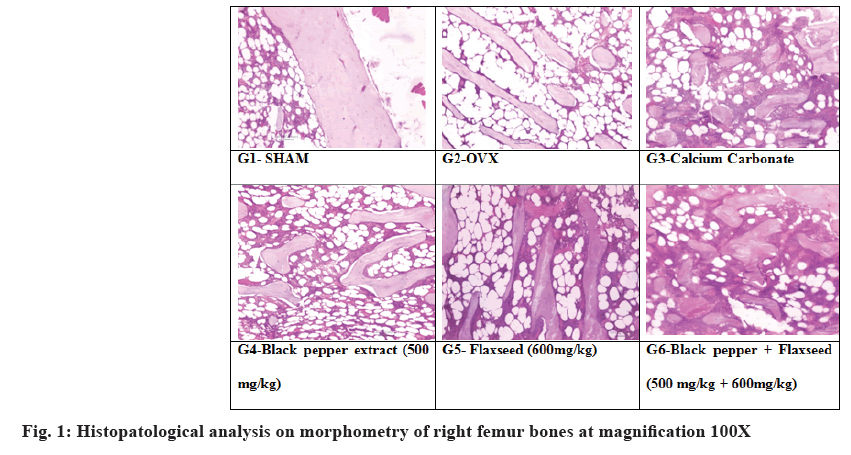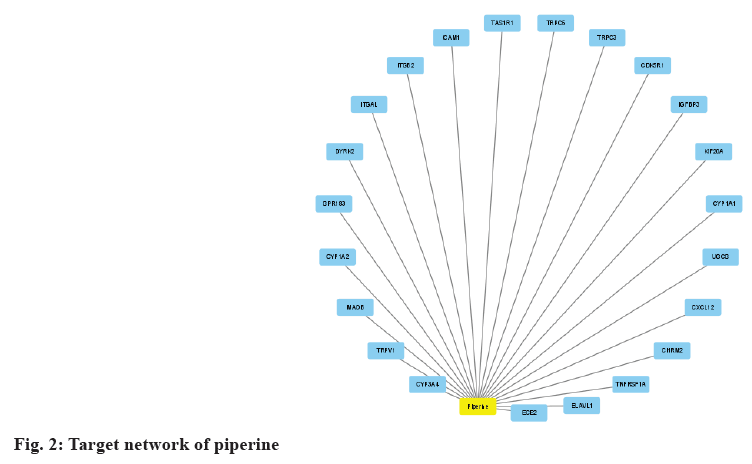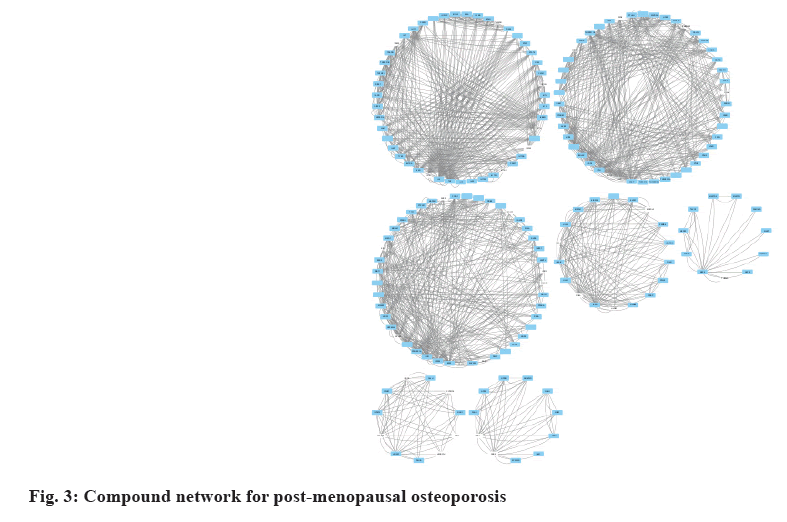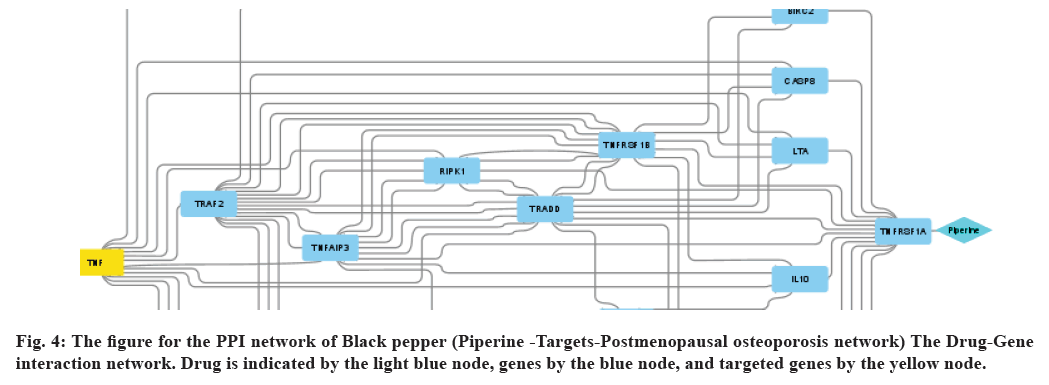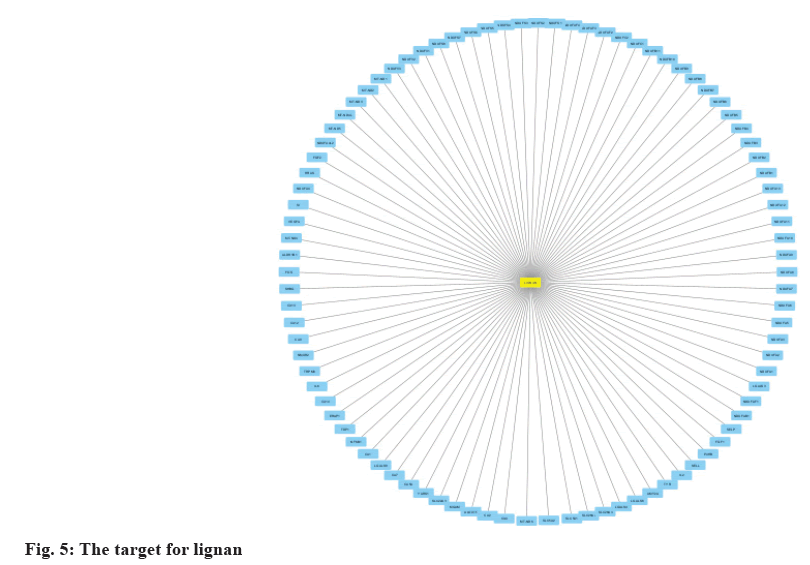- *Corresponding Author:
- Ayushi Pandey
Department of Pharmacology, KIET School of Pharmacy, KIET Group of Institutions, Ghaziabad, Uttar Pradesh 201206, India
E-mail: pandeyayushi986@gmail.com
| Date of Received | 21 September 2023 |
| Date of Revision | 19 March 2023 |
| Date of Acceptance | 15 July 2024 |
| Indian J Pharm Sci 2024;86(4):1394-1400 |
This is an open access article distributed under the terms of the Creative Commons Attribution-NonCommercial-ShareAlike 3.0 License, which allows others to remix, tweak, and build upon the work non-commercially, as long as the author is credited and the new creations are licensed under the identical terms
Abstract
Ovariectomy induced osteoporosis in rats is similar to oestrogen depleted postmenopausal osteoporosis in females. Osteoporosis after menopause is a serious global health issue in elderly populations that have shown minimal consideration until lately. Anti-resorptive medicines such as oestrogen, calcitonin, bisphosphonates and others are used in traditional treatments for postmenopausal osteoporosis. These have various negative effects and do not modify bone mass or replace bone that has already been lost. The goal of this study was to see if a herbal extract combination (Piper nigrum and Linum usitatissimum) might prevent ovariectomized rats from osteoporosis. 10-12 w of age female rats are randomized into six groups of six rats each. The sham-operated group, the control group and four other ovariectomized groups, ovariectomized with standard (calcium carbonate 250 mg/kg); ovariectomized with black pepper extract (500 mg/kg), and ovariectomized with flaxseed extract (600 mg/kg) are treated for 14 d by oral dosing. The in silico study revealed that lignan has a direct interaction with gene interleukin-6 and an indirect connection with CYP4F2 and piperine indirectly inhibit tumor necrosis factor gene. The present study reveals that a combination of Piper nigrum and Linum usitatissimum extracts has given significant results when compared to these extracts if given alone in the estimation of various bone turnover markers alkaline phosphatase, calcium, phosphorus, total protein content and histopathology of the right leg femur bone. To summing up, Piper nigrum and Linum usitatissimum extract has a definite anti-osteoporotic activity and could be used as an analogous treatment for postmenopausal osteoporosis.
Keywords
Ovariectomy, in silico, osteoporosis, Piper nigrum, Linum usitatissimum
A skeletal condition called osteoporosis is associated with low Bone Mineral Density (BMD), bone matrix degradation, softening of the bone, and an elevated risk of bone fracture. This is a frequent reason for bone fractures in the older population as well as in menopausal women. The (World Health Organization) WHO defines osteoporosis as a Bone Mineral Density Test BMD T-score that is lower than -2.5 as determined by Dual-emission X-ray Absorptiometry (DXA)[1]. Approximately 1 in 5 males and 1 in 3 women, or 200 million people globally, may have pain and fracture over their lifetime. Osteoporosis in post-menopausal women is due to the low level of oestrogen, which results in an increase in the number of osteoclasts and a reduction in bone resorption. Low amount of oestrogen induces low levels of Osteoprogenitor cells (OPG), which raises Receptor Activator of Nuclear factor Kappa-Beta (β) Ligand (RANKL), resulting in osteoporosis[2]. Hormone Replacement Therapy (HRT) is one of the most popular and efficient methods for preventing bone loss. On the other hand, HRT increases the risk of vaginal bleeding, thromboembolic events, endometrial cancer, breast cancer, and ovarian cancer[3]. Modern osteoporosis medication like immunosuppressants, corticosteroids, and 5-aminosalicylates has various side effects including illness, hypertension, diarrhea, and renal problems[4]. Flaxseed (Linum usitatissimum L.), among the world's oldest crops grown, is a Linaceae family plant that includes lignans and a cyclic peptide that have been found to prevent osteoclast development[5]. Anti- osteoclastogenic properties through disrupting p38/c-Fos/NFATc1 signalling and inhibition of osteoclast activity by disrupting cytoskeletal reorganization have been observed during the usage of Piper nigrum (black pepper)[6].
Network pharmacology is a method to study multi- path interaction and to analyze the multitargeted drug. Through network pharmacology, efforts are being made to determine the proteins that piperine and lignan target to treat post-menopausal osteoporosis. In the present investigation, post- menopausal osteoporosis targets were obtained from DisGeNET and string database, followed by network construction through cytoscape[7]. Nodes (node-link diagrams) are commonly used to represent pathways, signalling pathways, Protein-Protein Interaction (PPI), as well as other physiological links in pharmacology networking. The problem with this depiction is that it makes these links look static, despite biological networks being known to change and evolve in response to cell proliferation, environmental influences, and evolutionary growth over time. There are several tools available, some of which are professional and others are free source (the bulk of which are online in silico tools). Freely available resources include web services such as pkCSM, SwissADME, Swiss target prediction, DisGeNET, String database and Cytoscape[8].
Materials and Methods
Chemicals:
Alkaline phosphatase (ALP), calcium, phosphorus, and total protein reagents for biochemical analysis and di-potassium hydrogen, formaldehyde solution, and monobasic potassium phosphate for histopathology were obtained from Central drug house, New Delhi. All other chemicals used in the study are purchased from local suppliers.
Experimental design:
Rats weighing 120-150 g, aged 10-12 w were divided into 5 groups of 6 at random. To conduct the experiment, rats were obtained from the National Institute of Biological Sciences, Greater Noida, and were housed in polypropylene cages. Prior to the initiation of the trial, the rats were acclimatized in light and dark conditions and provided with pellet food and water without restriction. Our institution's Animal Ethics Committee guidelines as well as the Ministry of Social Justice and Empowerment regulations were followed during this research (IAEC No. IAEC/KSOP/2021/03). All animals were weighed at the beginning of the treatment period, and blood samples were obtained at the end of treatment with flaxseed and black pepper extract from rats of all groups through retro-orbital technique to analyze biochemical parameters. The animals were subsequently killed with an overdose of isoflurane. The right femur was collected and weighed immediately afterwards. Then, it was fixed in formalin solution and the bone was subjected to histopathological studies. Animals were divided into six groups (6 rats/group) as follows: Group I (control) included Sham-operated (Sham) rats, group II (induction) consisted of vehicle-treated Ovariectomized (OVX) rats, group III (co-treatment) received calcium carbonate (250 mg/animal/d), group IV received an oral dose of black pepper extract (500 mg/kg)[9], group V received an oral dose of flaxseed extract (600 mg/kg)[10], and group VI received an oral dose of a combination of flaxseed (600 mg/ kg) and black pepper (500 mg/kg) (Table 1).
| Group | Serum ALP (IU/L) | Serum calcium (mg/dl) | Serum phosphorus (mg/dl) | Serum total protein (g/dl) |
|---|---|---|---|---|
| G1 (Sham) | 148.95±8.31 | 10.06±0.12 | 5.98±0.14 | 6.84±0.05 |
| G2 (OVX) | 352.55±11.30 | 7.60±0.26 | 4.04±0.19 | 4.22±0.15 |
| G3 (calcium carbobate) | 184.47±11.83 | 10.47±0.30 | 5.13±0.22 | 6.57±0.14 |
| G4 Piper nigrum (ethanolic extract) | 172.80±11.14 | 10.26±0.19 | 5.11±0.16 | 6.77± 0.08 |
| G5 Linum sitatissimum (methanolic extract) | 172.27±13.51 | 10.52±0.16 | 5.08±0.22 | 6.50±0.12 |
| G6 Piper nigrum+Linum usitatissimum | 147.35±9.72 | 11.81±0.91 | 6.32±0.12 | 6.95±0.30 |
Table 1: Biochemical Parameters (Mean±Sem)
Surgical procedure for ovariectomy:
A transverse peritoneal slit on the central section of the lower abdomen, rightwards with a sterile scalpel blade. The adipose tissue was moved out from the right uterine lining that was surrounded by fat. To avoid detachment of a narrow section of the ovary, the periovarian fat with the ovary was gently pushed away from the incision site. Once ovary was identified and uterine horn, the ovaries were excluded and a braided silk suture (3/0) was used around the region of the uterine horns that was sectioned later. The ovaries were removed, and the uterine horn was released. With sterile sutures, the incision is sealed in 2 layers firstly absorbable suture was used to sew the muscle layers, and then non-absorbable suture was used to connect the skin[11].
Collection of blood and preparation of serum:
The blood was taken on the final date of the research study. Blood was collected using a retro- orbital method. For blood collection, the animals were anaesthetized with inhalation of isoflurane. In the centrifuge tubes, around 2 ml of blood sample was taken. After the blood was drawn, the samples were allowed to clot and then centrifuged to extract the serum. The 2 ml eppendorf tubes were spun for 15 min at 1300 RMP using a remi cooling centrifuge apparatus after the formation of the blood clot. The serum was then collected into 1 ml eppendorf tubes and analyzed for biochemical characteristics[12].
Histopathological evaluation:
The femur bone was removed from the right leg after sacrificing rats. The rat bone was fixed in 10 % formaldehyde, processed and then sections were cut in a 3 mm thickness after embedding in paraffin wax, and then stained with hematoxylin and eosin. The Nikon Eclipse E-200 photomicrographic system was used to examine the sections[13].
In silico procedure for determination of the biological pathway of black pepper (piperine) and flaxseed (lignan):
Target proteins of piperine and lignan: Using the reduced molecular input line entry specification, piperine data were further entered into the Similarity Ensemble Approach (SEA) (https://sea.bkslab.org/) (SMILES). It uses a similar technique to partition a collection of ligands into hundreds of sets based on their carbon skeletons, quantitatively correlating their annotated targets to one another. Only human-targeted genes were discovered, and information on these genes was obtained.
Potential targets in post-menopausal osteoporosis: DisGeNET (http://www.disgenet.org) and the Search Tool for the Retrieval of Interaction Genes (STRING) database (https://string-db.org/) supplied all of the proteins associated with post-menopausal osteoporosis. This method yields 78 proteins after merging the genes from the two data sets. A group of 1793 proteins has been discovered as a potential target for controlling postmenopausal osteoporosis molecular features.
PPI data: The STRING database, which provides details on predicted and investigated protein correlations, was used to collect the PPI data. The STRING database also specifies.
Network construction: The piperine targets network was constructed by linking piperine to its targets in the SEA Database. Proteins that interact with other proteins were linked using PPI information from the STRING and DisGeNET databases to generate PPI network targets for postmenopausal osteoporosis. The piperine- targets-postmenopausal osteoporosis network was built by combining the proteins that mediate piperine in the two previous networks with the help of Cytoscape. (http://cytoscape.org).
In the same way, by linking lignan to its targets in the SEA Database, the lignan-targets network was created. Proteins that interact with other proteins were linked using PPI information from the STRING and DisGeNET databases to generate PPI network targets for postmenopausal osteoporosis. The lignan-targets-postmenopausal osteoporosis network was built by keeping the proteins that mediate lignan in the previous two networks with the help of Cytoscape.
Results and Discussion
Mild body weight loss has been observed in the treatment group (G3) animals during the treatment period. However, that wasn’t statistically significant as compared to control group (G1). There was a notable rise in mean body weight values in ovariectomy-induced osteoporosis treated group (G3, G4 and G5) as compared to a normal control group (G1). On treating the animals orally with an extract of Linum usitatissimum and Piper nigrum given to ovariectomy-induced osteoporosis rats for 14 d with the dose of 600 mg/kg and 500 mg/ kg showed a significant change in body weight respectively with the value of shown below. The methanolic extract Linum usitatissimum 600 mg/ kg/bodyweight indicated a lower reduction in body weight. Standard calcium carbonate, when given orally, resulted in a notable increase in body weight to normal levels, as shown in the table below (Table 2).
| Group | WEEK | ||
|---|---|---|---|
| 1st d | 7th d | 14th d | |
| G1 (SHAM) | 261.53±5.18 | 260.44±4.22 | 268.29±4.26 |
| G2 (OVX) | 284.30±10.53 | 309.61±13.04 | 306.23±8.22 |
| G3 (calcium carbobate) | 323.2±13.36 | 321.65±13.47 | 332.04±15.00 |
| G4 Piper nigrum (ethanolic extract) | 326.2±19.13 | 332.87±16.77 | 357.96±11.33 |
| G5 Linum usitatissimum (methanolic extract) | 272.00±9.22 | 278.57±8.76 | 311.71±8.56 |
| G6 Piper nigrum+Linum usitatissimum | 264.72±7.75 | 285.6±27.96 | 312.12±6.50 |
Table 2: Body Weight (Mean±Sem)
The results of serum ALP level in the OVX rats (G2) was higher as compared with the Sham group (G1), the (Linum usitatissimum (G5) and Piper nigrum (G4) treatment groups lowered ALP levels in comparison to the OVX model group (G2), and combination of Linum usitatissimum and Piper nigrum (G6) has shown a more significant decrease in ALP level as compare to OVX rats (G2) group. The results of serum calcium and phosphorus level were lowered in OVX rats (G2) as compared with the Sham group (G1). The administration of (Linum usitatissimum (G5) and Piper nigrum (G4) alone has raised the level of Calcium (Ca) and Phosphorus (P) and the combination of both extract groups (G6) have shown more significant results which indicated that the combination of both extracts has shown better effect in treatment group as well as CaCO3 group (G3).
The results of total protein level in the OVX rats (G2) is lower as compared with the Sham group (G1), the (Linum usitatissimum (G5) and Piper nigrum (G4) treatment groups, increased the total protein level compared to OVX model group (G2), and combination of Linum usitatissimum and Piper nigrum (G6) has shown more increase in total protein level. A combination of both extracts has shown effect in treatment group as well as the CaCO3 group.
In the present study, we conducted a bone histological analysis using Hematoxylin and Eosin staining (H&E) staining to evaluate both the femoral cortical and trabecular bone microarchitecture. The (G2 group) OVX female rats developed osteoporosis and increased trabecular bone breaking, as seen in (fig. 1). Comparing the OVX model group to the Sham group, ovariectomy caused a reduction in the area of trabecular bone. The bones in the model calcium carbonate standard groups have shown an increase in bone cells compared to Sham group. Rats that had undergone ovariectomy and were given Linum usitatissimum and Piper nigrum showed increased trabecular bone area. 96 proteins have been identified as piperine's targets, as shown in (fig. 2) and 128 proteins forlignan by using the SEA. The collection of targets from the database would be referred to as the cluster of proteins that are piperine-targeted. By searching the DisGeNET and STRING database, 189 proteins were documented as the disease-specific targets of osteosarcoma. These 189 proteins are defined as post-menopausal osteoporosis-related proteins and the interaction between these proteins was demonstrated in (fig. 3). Among these 189 proteins, 13 proteins, including Arrestin β 2 (ARRB2), Dual Specificity protein Phosphatase 1 (DUSP1), Mitogen-Activated Protein kinase 1 (MAP2K1), Growth factor Receptor-Bound protein 2 (GRB2), Interleukin (IL) 17A, IL-6, Tumor Necrosis Factor (TNF), Mediator complex subunit 1 (MED1), Tumor Necrosis Factor Receptor Superfamily member 1 (TNFRSF1) and Jun proto-oncogene (JUN) were reported to participate in the pathological process of post-menopausal osteoporosis directly.
In terms of understanding the mechanism of action of piperine and lignan in post-menopausal osteoporosis conditions, the target proteins of the disease are linked with the target proteins of both drugs (piperine and lignan). Firstly, 10 proteins were selected as key targets of lignan and piperine that act on post-menopausal osteoporosis. These proteins are (Mitogen-Activated Protein Kinase 3 (MAPK3), IL-6, Estrogen Receptor 2 (ESR2), ESR1, TNF, Parathyroid Hormone (PTH), Nuclear Receptor Interacting Protein 1 (NRIP1), Cannabinoid Receptor 2 (CNR2) and Microtubule- Associated Protein 9 (MAP9)). Then Cytoscape software was used to integrate key targets of lignan and piperine with targets of post-menopausal osteoporosis which construct the PPI network for both drugs separately.
As shown in (fig. 4) the drug-gene network represents, that piperine indirectly inhibits the TNF gene, which helps in the reduction of bone reabsorption by reducing RANKL. For lignan the drug-gene network represents, that lignan has a direct interaction with gene IL-6 and an indirect connection with CYP4F2 (fig. 5 and fig. 6). For improvement of osteoporosis, the CYP4F2 influence the catabolism of menaquinone-4 (MK4) which increase the mitochondrial transport through Steroid and Xenobiotic Receptor (SXR) ligand for nuclear receptor leading to an increase in calcium level by regulating vitamin K. Lignan also inhibit IL-6 which causes a decrease in TRAF6 gene causes a decrease in osteoclast formation.
Conclusion
With the help of different test methods such as calcium, phosphorus, total protein content, and alkaline phosphatase serum levels, we summarized that the combination of Linum usitatissimum (methanolic extract) and Piper nigrum (ethanolic extract) in G6 has shown significant results compared to Linum usitatissimum (methanolic extract) in G5 and Piper nigrum (ethanolic extract) in G4 alone[14]. For piperine, the drug-gene network indicates that piperine indirectly inhibits the TNF gene, which helps in reducing bone resorption by lowering RANKL levels. For lignan, the drug-gene network shows that lignan has a direct interaction with the IL-6 gene and an indirect connection with CYP4F2. For the improvement of osteoporosis, CYP4F2 influences the catabolism of MK-4, which increases mitochondrial transport through the SXR ligand for the nuclear receptor. This leads to an increase in calcium levels by regulating vitamin K. Lignan also inhibit IL-6 which causes decrease in TRAF6 gene causes decrease in osteoclast formation.
Acknowledgements:
The authors are very grateful to Director Dr. (Col) A. Garg and joint Director Dr. Manoj Goel, for the providing the essential facilities for completion of this research work successfully.
Conflict of interests:
The authors declared no conflict of interests.
References
- Armas LA, Recker RR. Pathophysiology of osteoporosis: New mechanistic insights. Endocrinol Metab Clin North Am 2012;41(3):475-86.
[Crossref] [Google Scholar] [PubMed]
- Paik J, Scott LJ. Romosozumab: A review in postmenopausal osteoporosis. Drugs Aging 2020;37(11):845-55.
[Crossref] [Google Scholar] [PubMed]
- Palumbo C, Ferretti M, Bertoni L, Cavani F, Resca E, Casolari B, et al. Influence of ferutinin on bone metabolism in ovariectomized rats. I: Role in preventing osteoporosis. J Bone Miner Metab 2009;27:538-45.
[Crossref] [Google Scholar] [PubMed]
- Zhang Z, Zhao Q, Liu T, Zhao H, Wang R, Li H, et al. Effect of vicenin-2 on ovariectomy-induced osteoporosis in rats. Biomed Pharmacother 2020;129:110474.
[Crossref] [Google Scholar] [PubMed]
- Kaneda T, Yoshida H, Nakajima Y, Toishi M, Nugroho AE, Morita H. Cyclolinopeptides, cyclic peptides from flaxseed with osteoclast differentiation inhibitory activity. Bioorg Med Chem Lett 2016;26(7):1760-1.
[Crossref] [Google Scholar] [PubMed]
- Deepak V, Kruger MC, Joubert A, Coetzee M. Piperine alleviates osteoclast formation through the p38/c?F os/NFAT c1 signaling axis. Biofactors 2015;41(6):403-13.
[Crossref] [Google Scholar] [PubMed]
- Jing C, Sun Z, Xie X, Zhang X, Wu S, Guo K, et al. Network pharmacology-based identification of the key mechanism of Qinghuo Rougan Formula acting on uveitis. Biomed Pharmacother 2019;120:109381.
[Crossref] [Google Scholar] [PubMed]
- Belenahalli S, Kandagalla S, Hanumanthappa M. A network pharmacology approach to investigate the pharmacological effect of curcumin and capsaicin targets in cancer angiogenesis by module-based PPI network analysis. J Protein Proteomics 2019;10:109-20.
- Takooree H, Aumeeruddy MZ, Rengasamy KR, Venugopala KN, Jeewon R, Zengin G, et al. A systematic review on black pepper (Piper nigrum L.): From folk uses to pharmacological applications. Crit Rev Food Sci Nutr 2019;59(sup1):S210-43.
[Crossref] [Google Scholar] [PubMed]
- Khalil AA, Aslam A, Khalid A, Shahid Q, Aslam M, Hlebová M, et al. Hypocholesterolemic effect of microwave assisted defatted flaxseed extract in experimental rats. J Microbiol Biotechnol Food sci 2020;10(3):493-9.
- Parvaneh M, Karimi G, Jamaluddin R, Ng MH, Zuriati I, Muhammad SI. Lactobacillus helveticus (ATCC 27558) upregulates Runx2 and Bmp2 and modulates bone mineral density in ovariectomy-induced bone loss rats. Clin Interv Aging 2018:1555-64.
[Crossref] [Google Scholar] [PubMed]
- Martins CA, Leyhausen G, Volk J, Geurtsen W. Curcumin in combination with piperine suppresses osteoclastogenesis in vitro. J Endod 2015;41(10):1638-45.
[Crossref] [Google Scholar] [PubMed]
- Yogesh HS, Chandrashekhar VM, Katti HR, Ganapaty S, Raghavendra HL, Gowda GK, et al. Anti-osteoporotic activity of aqueous-methanol extract of Berberis aristata in ovariectomized rats. J Ethnopharmacol 2011;134(2):334-8.
[Crossref] [Google Scholar] [PubMed]
- Zhang Y, Yu L, Ao M, Jin W. Effect of ethanol extract of Lepidium meyenii Walp. on osteoporosis in ovariectomized rat. J Ethnopharmacol 2006;105(1-2):274-9.
[Crossref] [Google Scholar] [PubMed]
